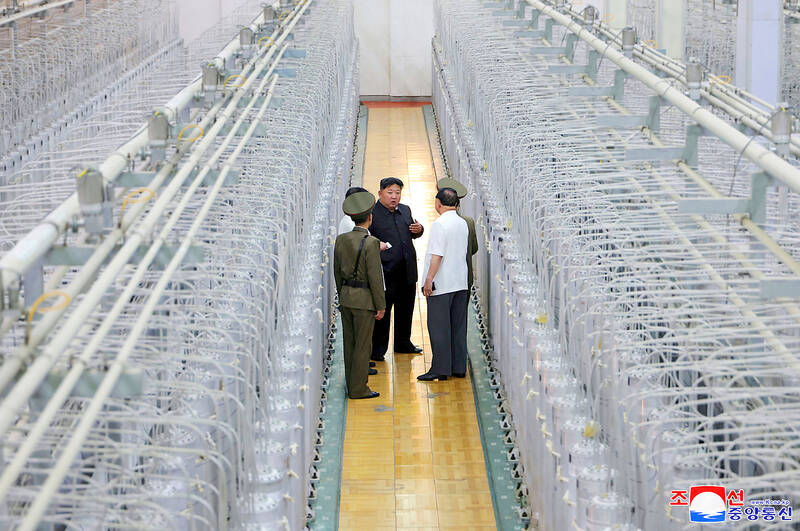North Korea is operating four uranium enrichment facilities, a top South Korean official said yesterday, adding to outside assessments that it has multiple covert atomic plants along with a widely known site near the capital, Pyongyang.
North Korean leader Kim Jong-un has called for a rapid expansion of his country’s nuclear weapons program and recently said he would never make the arms a negotiating point in response to overtures by US President Donald Trump.
South Korean Minister of Unification Chung Dong-young said that uranium enrichment centrifuges at the four facilities — which would include the known site at Yongbyon, about 100km north of Pyongyang — are running every day and stressed the urgency to stop the North’s nuclear program.

Photo: Korean Central News Agency, Korea News Service via AP
Chung did not elaborate further on the location of the other, undeclared nuclear sites.
He cited an assessment that North Korea possesses 2,000kg of highly enriched uranium. He first said that was based on intelligence agencies’ estimates, but the ministry later clarified it was attributed to civilian experts.
If confirmed, the amount would also signal a sharp increase in North Korea’s stockpile of nuclear material.
“Even at this very hour, North Korea’s uranium centrifuges are operating at four sites,” Chung told local reporters.
“Only five to six kilograms of plutonium is enough to build a single nuclear bomb,” he said, adding that 2,000kg of highly enriched uranium, which could be reserved solely for plutonium production, would be “enough to make an enormous number of nuclear weapons.”
Chung said that “stopping North Korea’s nuclear development is an urgent matter,” but added that sanctions would not be effective and that the only solution lies in a summit between Pyongyang and Washington.
In 2018, Stanford University academics, including nuclear physicist Siegfried Hecker who had previously visited the Yongbyon complex, said the North had about 250kg to 500kg of highly enriched uranium, sufficient for 25 to 30 nuclear devices.
Nuclear weapons can be built using either highly enriched uranium or plutonium, and North Korea has facilities to produce both at Yongbyon.
Last year, North Korea released photographs of what it said was a uranium enrichment facility, the first such disclosure since it showed the one at Yongbyon to Hecker and others in 2010.
The location and other details of the facility in the photographs remain unknown.
Additional reporting by AFP

‘WIN-WIN’: The Philippines, and central and eastern European countries are important potential drone cooperation partners, Minister of Foreign Affairs Lin Chia-lung said Minister of Foreign Affairs Lin Chia-lung (林佳龍) in an interview published yesterday confirmed that there are joint ventures between Taiwan and Poland in the drone industry. Lin made the remark in an exclusive interview with the Chinese-language Liberty Times (the Taipei Times’ sister paper). The government-backed Taiwan Excellence Drone International Business Opportunities Alliance and the Polish Chamber of Unmanned Systems on Wednesday last week signed a memorandum of understanding in Poland to develop a “non-China” supply chain for drones and work together on key technologies. Asked if Taiwan prioritized Poland among central and eastern European countries in drone collaboration, Lin

The Chien Feng IV (勁蜂, Mighty Hornet) loitering munition is on track to enter flight tests next month in connection with potential adoption by Taiwanese and US armed forces, a government source said yesterday. The kamikaze drone, which boasts a range of 1,000km, debuted at the Taipei Aerospace and Defense Technology Exhibition in September, the official said on condition of anonymity. The Chungshan Institute of Science and Technology and US-based Kratos Defense jointly developed the platform by leveraging the engine and airframe of the latter’s MQM-178 Firejet target drone, they said. The uncrewed aerial vehicle is designed to utilize an artificial intelligence computer

Renewed border fighting between Thailand and Cambodia showed no signs of abating yesterday, leaving hundreds of thousands of displaced people in both countries living in strained conditions as more flooded into temporary shelters. Reporters on the Thai side of the border heard sounds of outgoing, indirect fire yesterday. About 400,000 people have been evacuated from affected areas in Thailand and about 700 schools closed while fighting was ongoing in four border provinces, said Thai Rear Admiral Surasant Kongsiri, a spokesman for the military. Cambodia evacuated more than 127,000 villagers and closed hundreds of schools, the Thai Ministry of Defense said. Thailand’s military announced that

CABINET APPROVAL: People seeking assisted reproduction must be assessed to determine whether they would be adequate parents, the planned changes say Proposed amendments to the Assisted Reproduction Act (人工生殖法) advanced yesterday by the Executive Yuan would grant married lesbian couples and single women access to legal assisted reproductive services. The proposed revisions are “based on the fundamental principle of respecting women’s reproductive autonomy,” Cabinet spokesperson Michelle Lee (李慧芝) quoted Vice Premier Cheng Li-chiun (鄭麗君), who presided over a Cabinet meeting earlier yesterday, as saying at the briefing. The draft amendment would be submitted to the legislature for review. The Ministry of Health and Welfare, which proposed the amendments, said that experts on children’s rights, gender equality, law and medicine attended cross-disciplinary meetings, adding that